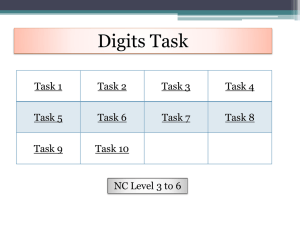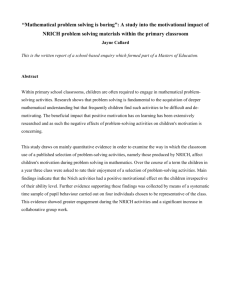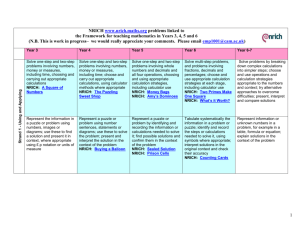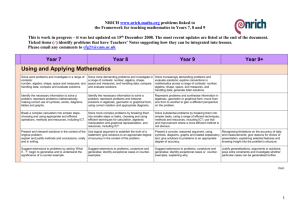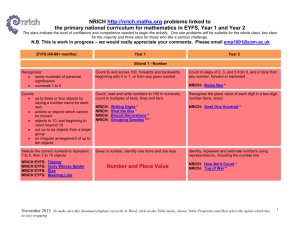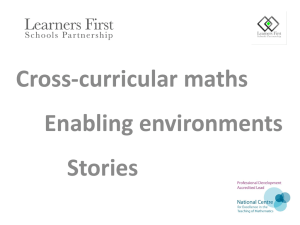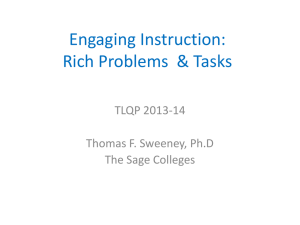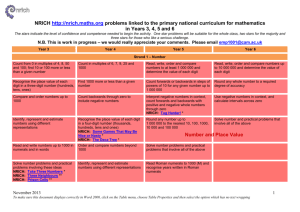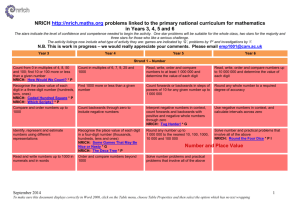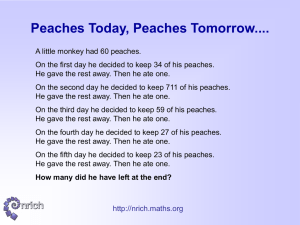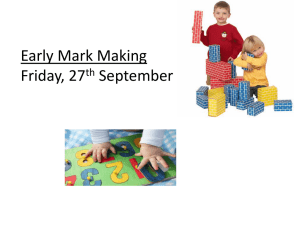Foundation
advertisement
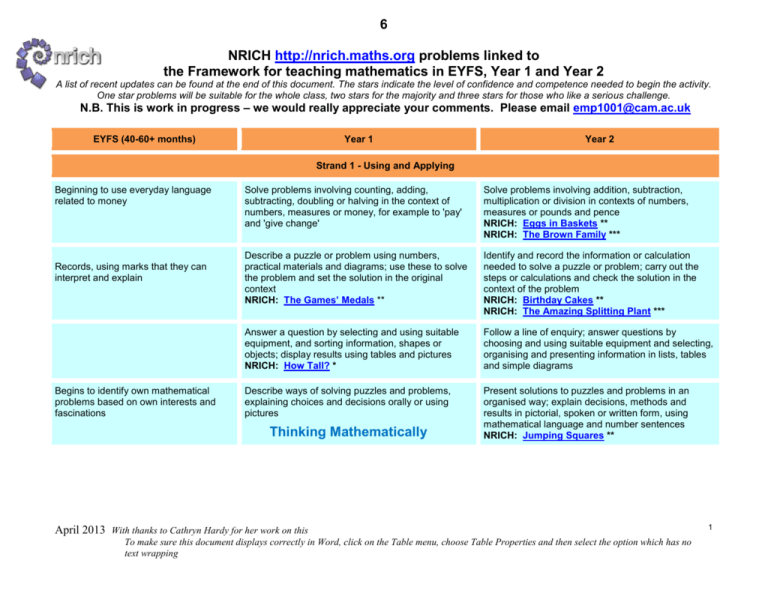
6 NRICH http://nrich.maths.org problems linked to the Framework for teaching mathematics in EYFS, Year 1 and Year 2 A list of recent updates can be found at the end of this document. The stars indicate the level of confidence and competence needed to begin the activity. One star problems will be suitable for the whole class, two stars for the majority and three stars for those who like a serious challenge. N.B. This is work in progress – we would really appreciate your comments. Please email emp1001@cam.ac.uk EYFS (40-60+ months) Year 1 Year 2 Strand 1 - Using and Applying Beginning to use everyday language related to money Records, using marks that they can interpret and explain Begins to identify own mathematical problems based on own interests and fascinations Solve problems involving counting, adding, subtracting, doubling or halving in the context of numbers, measures or money, for example to 'pay' and 'give change' Solve problems involving addition, subtraction, multiplication or division in contexts of numbers, measures or pounds and pence NRICH: Eggs in Baskets ** NRICH: The Brown Family *** Describe a puzzle or problem using numbers, practical materials and diagrams; use these to solve the problem and set the solution in the original context NRICH: The Games’ Medals ** Identify and record the information or calculation needed to solve a puzzle or problem; carry out the steps or calculations and check the solution in the context of the problem NRICH: Birthday Cakes ** NRICH: The Amazing Splitting Plant *** Answer a question by selecting and using suitable equipment, and sorting information, shapes or objects; display results using tables and pictures NRICH: How Tall? * Follow a line of enquiry; answer questions by choosing and using suitable equipment and selecting, organising and presenting information in lists, tables and simple diagrams Describe ways of solving puzzles and problems, explaining choices and decisions orally or using pictures Present solutions to puzzles and problems in an organised way; explain decisions, methods and results in pictorial, spoken or written form, using mathematical language and number sentences NRICH: Jumping Squares ** Thinking Mathematically April 2013 With thanks to Cathryn Hardy for her work on this To make sure this document displays correctly in Word, click on the Table menu, choose Table Properties and then select the option which has no text wrapping 1 Describe simple patterns and relationships involving numbers or shapes; decide whether examples satisfy given conditions NRICH: Our Numbers * NRICH: Poly Plug Pattern * Patterns and Sequences EYFS (40-60+ months) Describe patterns and relationships involving numbers or shapes, make predictions and test these with examples NRICH: Caterpillars ** NRICH: I Like … * NRICH: Light the Lights *** NRICH: What’s in a Name? ** NRICH: The Animals’ Sports Day * NRICH: Walking Round a Triangle * NRICH: Count the Digits * NRICH: Sitting Round the Party Tables * Year 1 Year 2 Strand 2 - Counting and Understanding Number Recognises some numerals of personal significance Recognises numerals 1 to 5 Counts up to three or four objects by saying one number name for each item Counts actions or objects which cannot be moved Counts objects to 10, and beginning to count beyond 10 Counts out up to six objects from a larger group Count reliably at least 20 objects, recognising that when rearranged the number of objects stays the same; estimate a number of objects that can be checked by counting NRICH: Making Sticks ** NRICH: Biscuit Decorations * NRICH: All Change * NRICH: How We’d Count * NRICH: Dotty Six * Counting and Ordering Read and write two-digit and three-digit numbers in figures and words; describe and extend number sequences and recognise odd and even numbers NRICH: Largest Even * NRICH: Even and Odd * NRICH: Ring a Ring of Numbers * NRICH: Domino Sequences * NRICH: Domino Number Patterns ** NRICH: Next Domino * NRICH: Two Numbers Under the Microscope ** NRICH: Odd Times Even *** NRICH: More Numbers in the Ring *** NRICH: How Odd ** Selects the correct numeral to represent 1 to 5, then 1 to 10 objects Counts an irregular arrangement of up to ten objects Finds the total number of items in two groups by counting all of them NRICH EYFS: NRICH EYFS: NRICH EYFS: NRICH EYFS: Tidying Incey Wincey Spider Dice Washing Line April 2013 With thanks to Cathryn Hardy for her work on this To make sure this document displays correctly in Word, click on the Table menu, choose Table Properties and then select the option which has no text wrapping 2 Uses the language of ‘more’ and ‘fewer’ to compare two sets of objects NRICH EYFS: Packing Estimates how many objects they can see and checks by counting them Compare and order numbers, using the related vocabulary; use the equals (equals) sign NRICH: Robot Monsters * NRICH: Sort Them Out (1) * Count up to 100 objects by grouping them and counting in tens, fives or twos; explain what each digit in a two-digit number represents, including numbers where 0 is a place holder; partition two-digit numbers in different ways, including into multiples of 10 and 1 NRICH: Grouping Goodies *** NRICH: Snail One Hundred * Read and write numerals from 0 to 20, then beyond; use knowledge of place value to position these numbers on a number track and number line NRICH: Tug of War * Place Value NRICH: Writing Digits * NRICH: Shut the Box * Order two-digit numbers and position them on a number line; use the greater than (greater than) and less than (less than) signs NRICH: 100 Square Jigsaw * NRICH: That Number Square! * Say the number that is 1 more or less than any given number, and 10 more or less for multiples of 10 Estimate a number of objects; round two-digit numbers to the nearest 10 Use the vocabulary of halves and quarters in context NRICH: Making Longer, Making Shorter ** Find one half, one quarter and three quarters of shapes and sets of objects NRICH: Halving ** NRICH: Happy Halving *** Says the number that is one more than a given number Finds one more or one less from a group of up to five objects, then ten objects ELG Children count reliably with numbers from one to 20, place them in order and say which number is one more or one less than a given number. Fractions EYFS (40-60+ months) Year 1 Year 2 Strand 3 – Knowing and Using Number Facts April 2013 With thanks to Cathryn Hardy for her work on this To make sure this document displays correctly in Word, click on the Table menu, choose Table Properties and then select the option which has no text wrapping 3 In practical activities and discussion, beginning to use the vocabulary involved in adding and subtracting NRICH EYFS: Number Rhymes Derive and recall all pairs of numbers with a total of 10 and addition facts for totals to at least 5; work out the corresponding subtraction facts NRICH: Cuisenaire Environment * NRICH: Domino Sorting * NRICH: One Big Triangle * Addition and Subtraction Derive and recall all addition and subtraction facts for each number to at least 10, all pairs with totals to 20 and all pairs of multiples of 10 with totals up to 100 NRICH: Weighted Numbers * NRICH: Number Balance ** NRICH: Pairs of Numbers * NRICH: Number Round Up *** NRICH: Cuisenaire Counting *** Count on or back in ones, twos, fives and tens and use this knowledge to derive the multiples of 2, 5 and 10 to the tenth multiple NRICH: Are You Well Balanced? *** NRICH: Buzzy Bee * Understand that halving is the inverse of doubling and derive and recall doubles of all numbers to 20, and the corresponding halves NRICH: The Tomato and the Bean *** NRICH: Different Sizes * NRICH: Doing and Undoing * Recall the doubles of all numbers to at least 10 NRICH: Magic Plant ** Derive and recall multiplication facts for the 2, 5 and 10 times-tables and the related division facts; Recognize multiples of 2, 5 and 10 NRICH: Clapping Times * NRICH: Lots of Lollies *** Multiplication and Division Use knowledge of number facts and operations to estimate and check answers to calculations Year 1 EYFS (40-60+ months) Year 2 Strand 4 – Calculating Addition and Subtraction Relate addition to counting on; recognise that addition can be done in any order; use practical and informal written methods to support the addition of a one-digit number or a multiple of 10 to a one-digit or two-digit number NRICH: Number Lines * NRICH: Getting the Balance *** NRICH: Ladybirds in the Garden ** NRICH: Tug of War * NRICH: Two Dice * Add or subtract mentally a one-digit number or a multiple of 10 to or from any two-digit number; use practical and informal written methods to add and subtract two-digit numbers NRICH: Butterfly Flowers * NRICH: Number Round Up *** NRICH: 4 Dom *** NRICH: Sort Them Out (1) * NRICH: Strike it Out * April 2013 With thanks to Cathryn Hardy for her work on this To make sure this document displays correctly in Word, click on the Table menu, choose Table Properties and then select the option which has no text wrapping 4 ELG Using quantities and objects, they add and subtract two single-digit numbers and count on or back to find the answer. They solve problems, including doubling, halving and sharing. Understand subtraction as ‘take away’ and find a ‘difference’ by counting up; use practical and informal written methods to support the subtraction of a onedigit number from a one digit or two-digit number and a multiple of 10 from a two-digit number NRICH: Find the Difference ** Understand that subtraction is the inverse of addition and vice versa; use this to derive and record related addition and subtraction number sentences NRICH: The Add and Take-away Path * NRICH: Secret Number ** NRICH: How Many? * NRICH: How Do You See it? * NRICH: What Was in the Box? * NRICH: Doing and Undoing * Use the vocabulary related to addition and subtraction and symbols to describe and record addition and subtraction number sentences NRICH: 2,4,6,8 *** Represent repeated addition and arrays as multiplication, and sharing and repeated subtraction (grouping) as division; use practical and informal written methods and related vocabulary to support multiplication and division, including calculations with remainders NRICH: Share Bears * NRICH: Ordering Cards * NRICH: Ip Dip * Solve practical problems that involve combining groups of 2, 5 or 10, or sharing into equal groups NRICH: Lots of Biscuits! * Use the symbols plus, -, multiplied by, divided by and equals to record and interpret number sentences involving all four operations; calculate the value of an unknown in a number sentence NRICH: Which Symbol? * NRICH: I’m Eight * NRICH EYFS: Maths Story Time Multiplication and Division EYFS (40-60+ months) Year 1 Year 2 Strand 5 – Understanding Shape April 2013 With thanks to Cathryn Hardy for her work on this To make sure this document displays correctly in Word, click on the Table menu, choose Table Properties and then select the option which has no text wrapping 5 Beginning to use mathematical names for ‘solid’ 3D shapes and ‘flat’ 2D shapes, and mathematical terms to describe shapes Selects a particular named shape Uses familiar objects and common shapes to create and recreate patterns and build models ELG They recognise, create and describe patterns. They explore characteristics of everyday objects and shapes and use mathematical language to describe them. NRICH EYFS: NRICH EYFS: NRICH EYFS: NRICH EYFS: NRICH EYFS: Visualise and name common 2-D shapes and 3-D solids and describe their features; use them to make patterns, pictures and models NRICH: Building with Solid Shapes * NRICH: A City of Towers ** NRICH: Chain of Changes ** NRICH: Shapely Lines * NRICH: What’s Happening? * NRICH: Shaping It * NRICH: Triple Cubes * Visualise common 2-D shapes and 3-D solids; identify shapes from pictures of them in different positions and orientations; sort, make and describe shapes, referring to their properties NRICH: Matching Triangles * NRICH: Complete the Square *** NRICH: Shadow Play *** NRICH: Skeleton Shapes ** NRICH: Let’s Investigate Triangles * NRICH: Poly Plug Rectangles * NRICH: Cubes * NRICH: Square It * NRICH: Data Shapes * NRICH: Inside Triangles *** NRICH: Rolling That Cube * Properties of Shape Making Footprints Paths Building Towers Exploring 2D Shape Wrapping Parcels Identify objects that turn about a point (e.g. scissors) or about a line (e.g. a door); recognise and make whole, half and quarter turns NRICH: Turning * Can describe their relative position such as ‘behind’ or ‘next to’ NRICH EYFS: Queuing Identify reflective symmetry in patterns and 2-D shapes and draw lines of symmetry in shapes NRICH: Colouring Triangles ** NRICH: Exploded Squares * Visualise and use everyday language to describe the Follow and give instructions involving position, position of objects and direction and distance when direction and movement moving them, for example when placing or moving objects on a game board NRICH: 2 Rings * Movement and Position NRICH: Olympic Rings ** NRICH: Tangram Tangle *** Recognise and use whole, half and quarter turns, both clockwise and anticlockwise; know that a right angle represents a quarter turn NRICH: Turning Man * April 2013 With thanks to Cathryn Hardy for her work on this To make sure this document displays correctly in Word, click on the Table menu, choose Table Properties and then select the option which has no text wrapping 6 EYFS (40-60+ months) Year 1 Year 2 Strand 6 - Measuring Orders two or three items by length or height Orders two items by weight or capacity NRICH EYFS: Making Caterpillars NRICH EYFS: Presents Estimate, measure, weigh and compare objects, choosing and using suitable uniform non-standard or standard units and measuring instruments (e.g. a lever balance, metre stick or measuring jug) NRICH: Sizing Them Up * NRICH: Wallpaper ** Estimating, Comparing and Measuring Uses everyday language related to time Orders and sequences familiar events Use vocabulary related to time; order days of the week and months; read the time to the hour and half hour NRICH: Times of Day * Measures short periods of time in simple ways ELG Children use everyday language to talk about size, weight, capacity, position, distance, time and money to compare quantities and objects and to solve problems. Estimate, compare and measure lengths, weights and capacities, choosing and using standard units (m, cm, kg, litre) and suitable measuring instruments NRICH: Little Man * NRICH: Order, Order! * NRICH: Can You Do it Too? ** NRICH: Discuss and Choose * Read the numbered divisions on a scale, and interpret the divisions between them (e.g. on a scale from 0 to 25 with intervals of 1 shown but only the divisions 0, 5, 10, 15 and 20 numbered); use a ruler to draw and measure lines to the nearest centimetre Time NRICH EYFS: Timing NRICH EYFS: Shopping Use units of time (seconds, minutes, hours, days) and know the relationships between them; read the time to the quarter hour; identify time intervals, including those that cross the hour NRICH: Stop the Clock *** NRICH: What’s the Time? * EYFS (40-60+ months) Year 1 Year 2 Strand 7 - Handling Data April 2013 With thanks to Cathryn Hardy for her work on this To make sure this document displays correctly in Word, click on the Table menu, choose Table Properties and then select the option which has no text wrapping 7 Answer a question by recording information in lists and tables; present outcomes using practical resources, pictures, block graphs or pictograms NRICH: Noah ** Data NRICH: Sticky Data * NRICH: Button-up * Answer a question by collecting and recording data in lists and tables; represent the data as block graphs or pictograms to show results; use ICT to organise and present data NRICH: Ladybird Count * NRICH: In the Playground * NRICH: Beads and Bags * Use diagrams to sort objects into groups according to a given criterion; suggest a different criterion for grouping the same objects NRICH: Sort the Street * NRICH: Mixed-up Socks ** NRICH: The Hair Colour Game ** Use lists, tables and diagrams to sort objects; explain choices using appropriate language, including 'not' NRICH: Carroll Diagrams * NRICH: What Shape and Colour?* NRICH: Plants ** NRICH: If the World Were a Village * Updates in September 2011: All Change, Poly Plug Rectangles Updates in December 2012: Matching Numbers, The Games’ Medals, How Tall?, Jumping Squares, Poly Plug Pattern, What’s in a Name?, The Animals’ Sports Day, Walking Round a Triangle, Count the Digits, Sitting Round the Party Tables, How We’d Count, Dotty Six, Two Numbers Under the Microscope, Odd Times Even, More Numbers in the Ring, How Odd, Sort Them Out (1), Snail One Hundred, Shut the Box, That Number Square!, Pairs of Legs, Cube Bricks and Daisy Chains, Number Round Up, Cuisenaire Counting, Different Sizes, Doing and Undoing, Tug of War, Two Dice, Strike it Out, How Do You See it?, What Was in the Box?, Ordering Cards, Ip Dip, I’m Eight, What’s Happening?, Shaping It, Triple Cubes, Cubes, Square it, Data Shapes, Inside Triangles, Rolling That Cube, Curve Spotting, Opening Patterns, Olympic Rings, Tangram Tangle, Can You Do it Too?, Discuss and Choose, What’s the Time?, Sticky Data, Button-up, Beads and Bags, The Hair Colour Game, Plants, If the World Were a Village April 2013 With thanks to Cathryn Hardy for her work on this To make sure this document displays correctly in Word, click on the Table menu, choose Table Properties and then select the option which has no text wrapping 8

